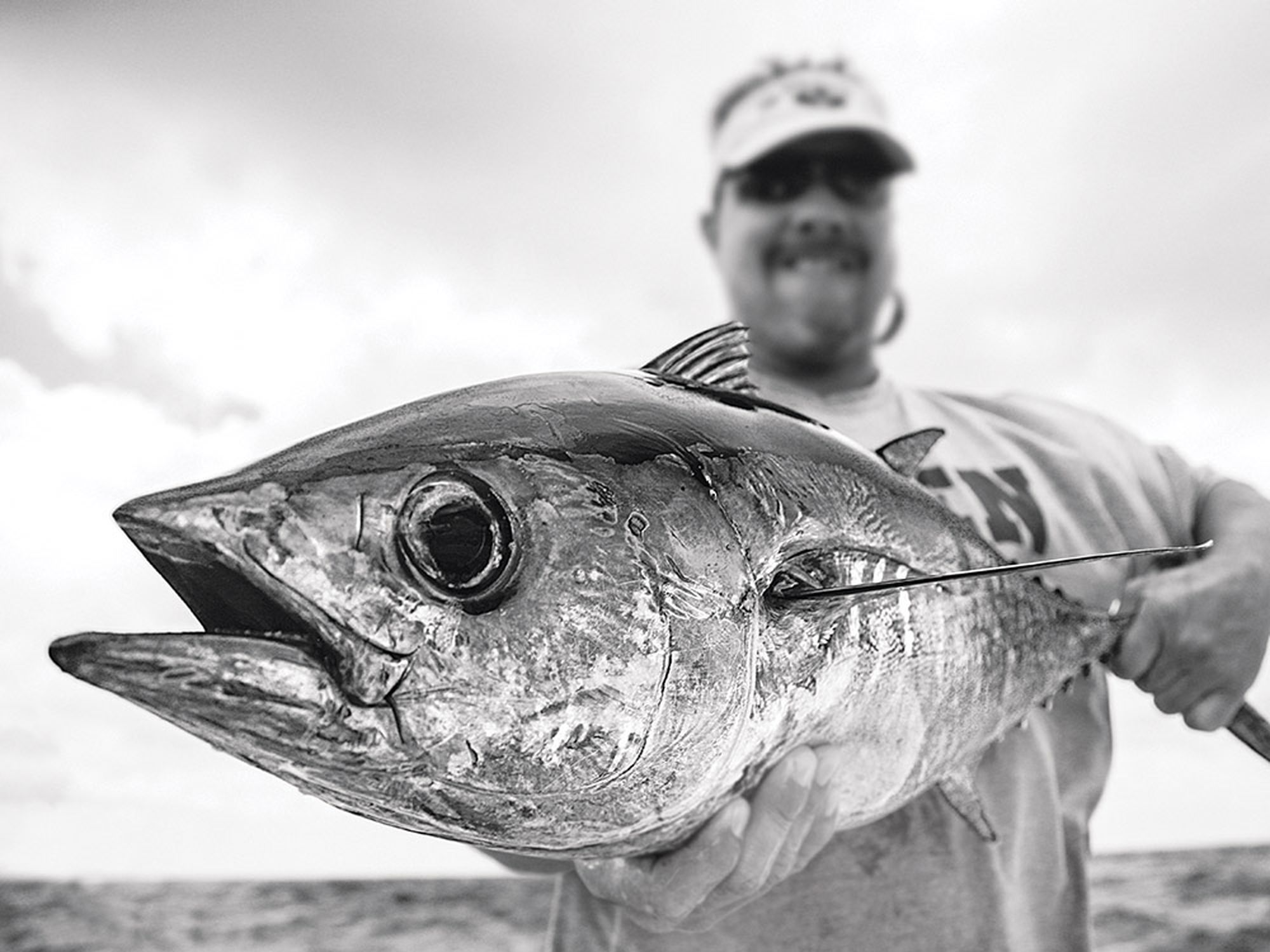Article Courtesy: saltwatersportsman.com | Originally Published: 10/24/2017 | Click here for original article
The Big Blackfin Tuna Search
Blackfin tuna compensate for their average football size with their vast numbers, but what about those elusive 20- to 30-plus-pounders.
Zones and Times
Capt. Bouncer Smith’s depth window for blackfins off the Miami-Fort Lauderdale area is 90 to 180 feet. He seeks out a knot or two of north current where the water flows offshore, avoiding wrecks, which attract sharks.
Blackfins are most active around sunrise and sunset. “I’ll set baits off a kite and flat lines, and one around 60 feet deep,” he says. “I’ll lightly chum with pilchards and pick away at them with large pilchards, herring and goggle-eyes until the big bite occurs.”
He rigs 20-pound tackle with 50-pound fluorocarbon leaders and 6/0 VMC Tournament circle hooks. If predators become an issue, he’ll step up to 30-pound gear. His top blackfins include trophies of 37 and 37½ pounds.
Gulf Coast Large
Off Bradenton and Sarasota Darren Blum boated one that bottomed out a 50-pound scale.
“We find large blackfins in 130- to 200-foot depths during summer, fish averaging 20 pounds,” he says. “During spring, they come in closer, often into 80 feet.” Blum looks for clean blue water and bait, and anchors.
He chums with pilchards, cigar minnows or sardine chunks. “We free-line two to four baits,” he says. “We let a live bait drift, then swim it back and repeat. Both live-chumming or chunking will hold the blackfins; we consistently catch them between 20 and 25 pounds, and some break 30 pounds.”
Blum prefers a 2/0, J-style hook and 60-pound fluorocarbon leader on 20-pound-class tackle.
Dig Deep
On the humps off Islamorada and Marathon, Capt. Ariel Medero goes after big blackfins where they live, from 200 to 350 feet down.
“I get up-current of the hump and set out lines at 250 feet and 350 feet,” he says. “I use 20-pound tackle with a 40-foot, 40-pound-test wind-on fluoro leader, a small barrel swivel, and 2 feet of 40-pound fluoro or — if the fish aren’t eating aggressively — 30-pound fluoro with a 2/0 or 3/0 J-style hook.
“I hook a live bait in through the lower jaw and out the upper jaw, free-line it out to the double line, then hang a 10-ounce sinker where the double line joins the leader. I lower one bait to 350 feet, and the other to 250 feet.”
Then Medero drifts across the hump. On the day he showed me his technique, we boated blackfins of 26, 27 and 33 pounds.
Peanuts and Elephants
Stepping up in bait size discourages small tuna. It may take longer to get a strike with big baits, but the fish that eat will be beauties. That 33-pounder taken by Medero ate a pinfish.
Lower Florida Keys/Shrimp Boats
Capt. Beau Woods targets blackfins between Cudjoe Key and the Marquesas. In the lower Keys, he anchors and live-chums with pilchards, and set up 200 feet up-current of a wreck, luring the tuna behind his boat. “If live bait is difficult to find, don’t fret,” says Woods. “Take cases of sardines or, leftover pilchards and freeze them.”
Woods favors 1/0 and 2/0 in-line circle hooks, free-lining baits on 25- and 30-pound pink fluorocarbon leaders. “Lighter leaders get more takers,” he says. “Circle hooks let you scale down the leader for those extra bites.”
Behind the shrimp boats “Keep the chum going and pull the fish with you as you drift away from the shrimper,” he says. Toss a few pieces of chum, and time your bait delivery for when a larger fish charges up.
Little keeps a couple of spinners rigged with popping plugs. “The plugs often get to them faster than baits,” he says. Little slow-trolls cigar minnows and hardtails on 4/0 circle hooks and 150-foot top shots of 40- to 60-pound fluorocarbon. I stay away from wire, since we’re looking for bites from big blackfins and sailfish.”
Hook Variations
Medero prefers a small J hook to counter the tuna’s exceptional vision and for a deep hook-set. The risk is the leader chafing, especially with 30-pound fluoro. We lost a few big tuna to that. While Medero is a master at catching large blackfins, instead I prefer a 3/0 or 4/0 in-line circle hook, based on bait size. My goal: a jaw-set, with the hook eye and the entire leader remaining outside the fish’s mouth, away from teeth and chafing.
Deep Rig for Blackfins
Tie the weight to several inches of light monofilament line with a snap swivel at the other end. Hook the open snap swivel over one leg of the double line, leaving the snap open. That takes the bait to the desired depth. Once you hook up, reel in the line to the sinker, pull it off the double line, and finish the fight unencumbered.












